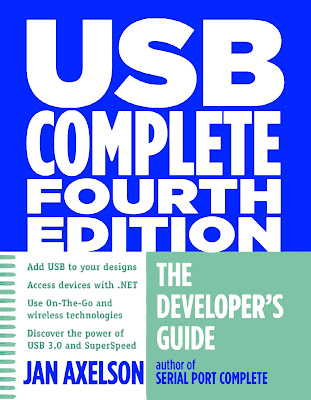 |
USB Complete The Developers Guide The Developers Guide Jan Axelson Fuente: Jan Axelson's Lakeview Research For: program listings, Code, List of corrections. Reseña This updated edition of the best-selling developer's guide to the Universal Serial Bus (USB) interface covers all aspects of project development, including hardware design, device firmware, and host application software. |
| Topics include how to choose a device controller chip, how to write device firmware for USB communications, how to cut development time by using USB device classes, and how to write software to access devices that perform vendor-specific functions. Also discussed are hardware interfacing, using bus power, wireless technologies, and USB On-The-Go. The book presents example code for accessing USB devices using Visual Basic .NET and Visual C# .NET. The example code shows how to detect device arrival and removal and how to transfer vendor-defined data using the human interface device class and Microsoft’s WinUSB driver. Also covered is how to write device firmware to communicate with the USB host. The Fourth Edition covers USB 3.0 and SuperSpeed and has new information on controller chips, USB classes, power use, and Microsoft’s WinUSB driver. Esta edición actualizada de la guía del programador de mayor venta de la interfaz de bus serie universal (USB) cubre todos los aspectos del desarrollo del proyecto, incluyendo el diseño del hardware, el firmware del dispositivo, y el software de la aplicación host. Los temas incluyen cómo elegir un chip controlador de dispositivo, la forma de escribir el firmware del dispositivo de comunicaciones USB, cómo reducir el tiempo de desarrollo mediante el uso de clases de dispositivos USB, y la forma de escribir software para acceder a los dispositivos que realizan funciones específicas del proveedor. También se discuten hardware interfaz, utilizando la alimentación del bus, las tecnologías inalámbricas y USB On-The-Go. El libro presenta código de ejemplo para acceder a los dispositivos USB que utilizan Visual C Basic. NET y Visual C #. NET. El código de ejemplo muestra cómo detectar el dispositivo de entrada y la eliminación y la forma de transferencia definido por el proveedor de datos utilizando la clase de dispositivo de interfaz humana y el conductor WinUSB de Microsoft. También se cubre la forma de escribir el firmware del dispositivo para comunicarse con el host USB. La cuarta edición abarca SuperSpeed USB 3.0 y y tiene nueva información sobre chips controladores USB, las clases, el uso de energía, y el driver WinUSB de Microsoft. |
| INDICE |
|
| Consulta el Libro (6 MB) por: |
| Para los que usan Gestores de Descarga |
http://adf.ly/NWklt
http://adf.ly/NWklu
http://adf.ly/NWklv
http://adf.ly/NWklx
|
INDICE GENERAL |
|

No hay comentarios:
Publicar un comentario
Me gustaría Saber: Quién eres y de Donde Eres. Deja de Ser un Anónimo. Que tengas un Buen Día.